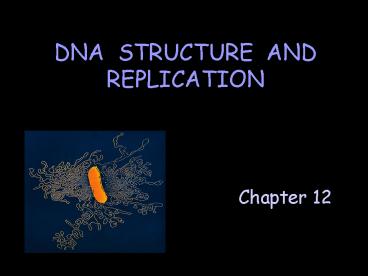DNA STRUCTURE AND REPLICATION - PowerPoint PPT Presentation
1 / 16
Title:
DNA STRUCTURE AND REPLICATION
Description:
one deoxyribose sugar (5 carbon sugar) one nitrogenous base (G, A, C or T) ... is semiconservative (Meselson & Stahl) Overview of DNA Replication: ... – PowerPoint PPT presentation
Number of Views:60
Avg rating:3.0/5.0
Title: DNA STRUCTURE AND REPLICATION
1
DNA STRUCTURE AND REPLICATION
- Chapter 12
2
- A. DNA Structure
- DNA is a nucleic acid composed of nucleotide
monomers. - DNA nucleotide consists of
- one phosphate group
- one deoxyribose sugar (5 carbon sugar)
- one nitrogenous base (G, A, C or T)
3
- DNA is a double-stranded helix (Watson Crick
1953).
- Sides of ladder make up sugar-phosphate
backbone. - Rungs of ladder composed of base pairs joined by
hydrogen bonds.
4
- Pyrimidines (T C) form hydrogen bonds with
purines (A G).
- Thymine pairs with Adenine, forming 2 hydrogen
bonds. - Cytosine pairs with Guanine, forming 3 hydrogen
bonds.
5
- DNA strands are antiparallel.
Numbering of strands is based on position of
deoxyribose sugars.
5 to 3 strand 3 to 5 strand
6
- DNA is highly condensed.
- DNA is wrapped tightly around proteins folded.
- DNA must unwind for replication to occur.
7
- B. DNA Replication
- Process by which DNA is duplicated.
- occurs during the S phase of Interphase
- is semiconservative (Meselson Stahl)
?
8
- Overview of DNA Replication
?Unreplicated DNA. ?Strands unzip at several
points creating replication forks. ?Each strand
serves as template for complementary nucleotides
to H-bond. ?New nucleotides of each daughter
strand are linked.
9
- Steps in DNA Replication
?Helicase breaks hydrogen bonds. ?Binding
proteins stabilize strands prevent them from
rejoining. ?Primase makes an RNA primer.
10
?Free nucleotides move in H-bond DNA
polymerase links nucleotides to each other
starting at primer working in the 5 to 3
direction. ?DNA polymerase proofreads new
strand (replaces incorrect bases).
11
?DNA replication is continuous on one
strand. ?DNA replication is discontinuous on
other strand, producing Okazaki fragments.
12
Ligase
?Repair enzymes remove RNA primers Ligase
connects Okazaki fragments.
13
Determine the base sequence of daughter DNA
replicated from the following parental DNA strand.
parental DNA C T A G G T A C
T daughter DNA G A T C C A T G A
14
- C. DNA Repair
- UV radiation damages DNA by causing thymine
dimers to form.
DNA damage can be repaired by photoreactivation
or excision repair.
15
- 1. Photoreactivation photolyase (enzyme) uses
light energy to split dimer.
2. Excision repair - repair enzyme cuts out
damaged area DNA polymerase inserts replacement
sequence ligase seals backbone.
16
- 3. Mismatch repair - enzymes proofread newly
replicated DNA for base mispairing correct the
error. - Faulty DNA repair results in chromosome breaks
an increased susceptibility to cancer. - Ex. Xeroderma pigmentosum































